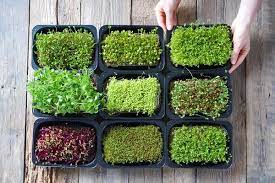Microgreens, the young and tender seedlings of vegetables and herbs, have been gaining immense popularity in recent years for their vibrant colors, intense flavors, and exceptional nutritional value. These tiny edible greens are harvested at an early stage, shortly after the emergence of their first true leaves. Despite their small size, microgreens pack a powerful punch in both taste and health benefits, making them a favorite among chefs, health enthusiasts, and home gardeners alike.
- What are Microgreens?
Microgreens are young plants that are harvested when they are only a few inches tall, typically within 7 to 21 days after germination. They are different from sprouts, which are harvested at an even earlier stage, as they grow beyond the cotyledon stage to develop their first set of true leaves. Common microgreens include arugula, broccoli, radish, kale, cilantro, and many more. These tiny greens are prized for their visually appealing colors, ranging from vibrant greens to deep purples and reds, adding an aesthetic touch to culinary presentations.
- Cultivating Microgreens
Microgreens can be cultivated indoors or outdoors, making them accessible year-round. Indoor cultivation using trays or containers filled with a growing medium like soil, coco coir, or hydroponic pads is a popular method. They require adequate light, preferably natural sunlight or grow lights, and consistent moisture levels. The short growing period and minimal space needed make them ideal for urban gardeners and those with limited gardening space.
- Flavor and Culinary Applications
One of the most captivating features of microgreens is their concentrated flavors. Despite their small size, they boast intense tastes that mimic the mature versions of the plants. For instance, microgreens of basil carry the same aromatic essence as full-grown basil leaves, while microgreens of radish have a mild peppery taste. Their distinctive flavors have led to their extensive use in garnishing and enhancing the taste of various dishes, such as salads, sandwiches, soups, omelets, and even sushi rolls.
- Nutritional Benefits
Microgreens are nutritional powerhouses, boasting higher nutrient levels compared to their mature counterparts. Studies have shown that microgreens can contain up to 40 times more essential vitamins, minerals, and antioxidants. They are rich in vitamins C, E, and K, beta-carotene, lutein, and zeaxanthin, all of which play vital roles in supporting overall health and well-being. Additionally, microgreens are a good source of fiber and have been associated with improved digestion and reduced risk of chronic diseases.
- Health and Wellness
Given their exceptional nutritional profile, microgreens have found a place in health-conscious diets and wellness routines. Their antioxidants help combat free radicals and oxidative stress, promoting cellular health and reducing inflammation. Incorporating microgreens into daily meals can contribute to enhanced immunity, improved skin health, and overall vitality.
Conclusion
In conclusion, microgreens have emerged as a versatile and exciting addition to the culinary world and the health-conscious community. These miniature greens not only add a burst of color and flavor to dishes but also offer a treasure trove of essential nutrients and health benefits. Whether you grow them at home or purchase them from local markets, microgreens are a simple and accessible way to elevate your meals while embracing the power of nutrition and taste in one tiny package.

